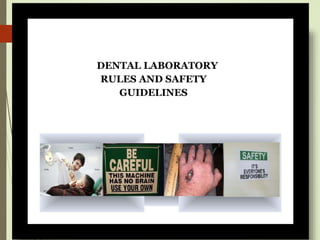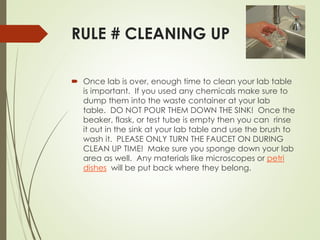Dental laboratory rules and safety guidelines
- 1. DENTAL LABORATORY RULES AND SAFETY GUIDELINES
- 2. Group Ī«Ī»oneĪ»Ī» Members : ? 214003786 ? 214003818 ? 215011872 ? 215007605 ? 215020414 ? 215004849 ? 215003090 Members : ? 215012847 ? 215001458 ? 215001497 ? 215008549 ? 215001047
- 3. Objectives These rules and guidelines aims : ? To help students understand the proper use of instruments and materials that are commonly used in dental labs ? To prevent accidents caused by neglect, improper usage of materials and equipments, and unfamiliarity. ? To prevent harm to equipments ? To prevent injury to the students and others( dental team members)
- 4. Introduction ? Each clinical setting in health sciences has its special rules so that it keeps protecting and improving the health of its clients. ? In order to work in a safe, organized and a productive environment ; we need to under work rules.
- 5. What is a dental lab ? ? Manufacture or customize a variety of products to assist in the provision of oral health care by a licensed dentist. These products includes: ? Crowns ? Bridges ? dentures and other dental products
- 7. Rule 1 Never operate machine without trai ning -it is must. Because: ? Dental equipment are very expensive ? It can harm your body parts when used badly. ? Use it in as instructed by the manufacturer or instructor.
- 8. Rule 2 Never work alone ©C always use Ī░buddy systemĪ▒. ? Two heads are better than one ? The buddy system provides broad ideas on practices and different cases. ? In case of accidents; you gate a direct support from your colleagues.
- 9. Rule 3 Never work with loose hair, jewelry, etc. ? Always remove or secure anythi ng that might get caught in moving machinery. ? They can interrupt with the product being prepared.
- 10. Rule 4 Never use machine when impaired ? be sober and smart
- 11. Rule 5 Never start work if you cannot do the job safely. ? Discuss with your supervisor for other options, other time.
- 12. Rule 6 Never wear open toe shoes ? Always wear closed®\toe shoes in the shop and labs. ? That aims to protect yourself not to be harmed by hushing chemicals, sharp materials,ĪŁ
- 13. Rule 7 Never work without proper eye protection ? Always wear appropriate safety glasses or goggles when working or cleaning tools in the dental lab.
- 14. Rule 8 Never bring hands close to sharp objects. ? always keep your hands at a safe distance from sharp tools.
- 15. Rule 9 ? Never create a dusty and smoky environment®\dust, chemicals and smoke can be dangerous so work in a well ventilated areas.
- 16. Rule 10 ? Never be shy to seek help ©Calways ask if youĪ»re unsure about the safe operation of A tool or any aspect of a job ©Chave lab colleague check the tool or work with which you are familiar.
- 17. Rule 11 Never leave your work area in a mess ©C always clean up after yourself
- 18. Rule 12 ? Never wear gloves while working on rotating equipment
- 19. Rule 13 ? Never leave broken or damaged tools or abnormal equipment unreported ©C always inform your supervisor to remove that from service and get it repaired.
- 20. Rule 14 ? Never make any adjustments to a machine when it is in operation. Before making adjustments always talk to your supervisor for permission
- 21. ADDITIONAL SAFETY RULES IN A DENTAL LAB.
- 22. Rule # WALK ? When going into the lab make sure to WALK. There will be no running in the lab. There will be materials and equipment out that can break if you accidently knock into them. There may be electrical wires on the ground that you may trip over as well. Please WALK and be careful.
- 23. RULE # HANDLING CHEMICALS ? When handling chemicals during lab it is important to proceed with caution. Wear gloves whenever pouring chemicals or handling them. If you have to dispose of chemicals, always use the waste containers provided on your lab tables. NEVER pour the chemicals back into the container you got it from. If you do, whatever was in your container could cause a chemical reaction with the chemical in the original container. ? Never smell a chemical directly. You can waft or fan the fumes toward yourself. You can do this by waving your hand over the flask or beaker.
- 24. RULE # HANDLING EQUIPMENT ? It it important that when you are using different lab equipment, you handle them with care. Microscopes should be held with both hands, one underneath and one on the arm. When handling glassware be sure to hold it with both hands when can. If something is hot, then make sure to use tongs. NEVER use your hands.
- 25. RULE # EYE WASH/SHOWER STATION ? If chemicals or particles get in your eyes, WALK to the eye wash station and rinse out your eyes for 15 minutes. Make sure that you keep your eyes OPEN when you rinse them. ? If chemicals get onto your skin, WALK to the shower station and pull on the red handle. Stand under the shower and rinse off your body for 15 minutes. ? ALWAYS make sure to tell the teacher when something like this happens when in academic laboratory.
- 26. RULE # FIRE SAFETY ? In the event that there is a fire during lab, WALK over to the fire extinguisher, pull out the safety pin, aim the nozzle towards the fire and push the handle .Empty out the entire tank. ? N.B: skills for usage are very important.
- 27. RULE # NO EATING/DRINKING IN LAB ? There will be NO eating or drinking during lab. The lab tables may have had chemicals on them previously that were not properly cleaned up so you should not eat or drink on them either. ? Sometimes we will be using food as materials in lab, this too should not be eaten unless I tell you it is ok. The food may have been stored next to chemicals in the lab and could be contaminated.
- 28. RULE # CLEANING UP ? Once lab is over, enough time to clean your lab table is important. If you used any chemicals make sure to dump them into the waste container at your lab table. DO NOT POUR THEM DOWN THE SINK! Once the beaker, flask, or test tube is empty then you can rinse it out in the sink at your lab table and use the brush to wash it. PLEASE ONLY TURN THE FAUCET ON DURING CLEAN UP TIME! Make sure you sponge down your lab area as well. Any materials like microscopes or petri dishes will be put back where they belong.
- 29. RULE#HAND WASHING ? Before leaving the lab ALWAYS wash your hands. Make sure you use soap and water and scrub your hands thoroughly at the hand washing station. Some of the materials we will be using could be harmful to you, so it is important that you wash your hands so you do not get sick.
- 30. Special thanks ? THANKS to James Kaznosky (Environmental Health and Safety)- DENTAL SHOP SAFETY(pdf)






























